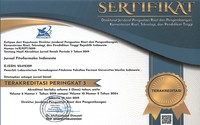Aktivitas Fraksi Air Kulit Batang Mahoni (Swietenia macrophylla King.) Dan Studi In Silico Senyawa Kimia Penghambat Enzim α-Glukosidase
Abstract
Keywords
Full Text:
PDF (Bahasa Indonesia)References
Ariani, N., Kartika, I. and Kurniadewi, F. (2017) ‘Uji Aktivitas Inhibisi Enzim α-Glukosidase secara In Vitro dari Ekstrak Metanol Daun Cryptocarya densiflora Blume dan Fraksi-Fraksinya’, Jurnal Riset Sains dan Kimia Terapan, 7(1), pp. 14–20. Available at: http://journal.unj.ac.id/unj/index.php/jrskt.
Aziz, Z. et al. (2019) ‘Identification of α-glucosidase Enzyme Inhibitor Compound from Ethanol 96% Extract of Yakon Leaves (Smallanthus sonchifolius [Poepp.& Endl.] H. Robinson)’, Jurnal Ilmu Kefarmasian Indonesia, 17(1), p. 21. doi: 10.35814/jifi.v17i1.652.
Chagas, C. M., Moss, S. and Alisaraie, L. (2018) ‘Drug metabolites and their effects on the development of adverse reactions: Revisiting Lipinski’s Rule of Five’, International Journal of Pharmaceutics. Elsevier, 549(1–2), pp. 133–149. doi: 10.1016/j.ijpharm.2018.07.046.
Choudhary, D. K. et al. (2020) ‘Characterization, inhibitory activity and mechanism of polyphenols from faba bean (gallic-acid and catechin) on α-glucosidase: insights from molecular docking and simulation study’, Preparative Biochemistry and Biotechnology. Taylor & Francis, 50(2), pp. 123–132. doi: 10.1080/10826068.2019.1679171.
Elya, B. et al. (2015) ‘Antidiabetic activity and phytochemical screening of extracts from indonesian plants by inhibition of alpha amylase, alpha glucosidase and dipeptidyl peptidase IV’, Pakistan Journal of Biological Sciences, 18(6), pp. 273–278. doi: 10.3923/pjbs.2015.279.284.
Falah, S. et al. (2010) ‘Hypoglycemic Effect of Mahogany (Swietenia macrophylla King) Bark Extracts in Alloxan-induced Diabetic Rats’, Wood Research Journal, 1(2), pp. 89–94.
Falah, S., Suzuki, T. and Katayama, T. (2007) ‘Chemical constituents from S.macrophylla bark and their antioxidant activity’, Pakistan Journal of Biological Sciences, 11(16), pp. 2007–2012.
Fasciotti, M. et al. (2013) ‘Wood Chemotaxonomy via ESI-MS profiles of phytochemical markers: The challenging case of African versus Brazilian Mahogany woods’, AIChE Annual Meeting, Conference Proceedings, pp. 1–0.
Ganeshpurkar, A. and Saluja, A. (2020) ‘The pharmacological potential of catechin’, Indian Journal of Biochemistry and Biophysics, 57(5), pp. 505–511.
Hashim, M. A. et al. (2013) ‘Anti-hyperglycaemic activity of Swietenia macrophylla king (meliaceae) seed extracts in normoglycaemic rats undergoing glucose tolerance tests’, Chinese Medicine (United Kingdom), 8(1), pp. 1–8. doi: 10.1186/1749-8546-8-11.
He, T. et al. (2020) ‘Machine learning models with quantitative wood anatomy data can discriminate between Swietenia macrophylla and Swietenia mahagoni’, Forests, 11(1), pp. 1–13. doi: 10.3390/f11010036.
Junaidi, L. (2019) Teknologi ekstraksi bahan aktif alam. Bogor: PT Penerbit IPB Press.
Kalaivanan, K. and Pugalendi, K. V. (2011) ‘Antihyperglycemic effect of the alcoholic seed extract of Swietenia macrophylla on streptozotocin-diabetic rats’, Pharmacognosy Research, 3(1), pp. 67–71. doi: 10.4103/0974-8490.79119.
Kelutur, F. J., Mustarichie, R. and Umar, A. K. (2020) ‘Virtual Screening Kandungan Senyawa Kipas Laut (Gorgonia mariae) sebagai Anti-Asma’, Alchemy Jurnal Penelitian Kimia, 16(2), p. 48. doi: 10.20961/alchemy.16.2.39965.48-59.
Kementerian Kesehatan RI (2018) ‘Laporan nasional riskesdas 2018’. doi: 10.1017/CBO9781107415324.004.
Lau, W. K. et al. (2015) ‘Potent PPARγ ligands from Swietenia macrophylla are capable of stimulating glucose uptake in muscle cells’, Molecules, 20(12), pp. 22301–22314. doi: 10.3390/molecules201219847.
Lin, B. D. et al. (2011) ‘Phragmalin-type limonoid orthoesters from the twigs of Swietenia macrophylla’, Chemical and Pharmaceutical Bulletin, 59(4), pp. 458–465. doi: 10.1248/cpb.59.458.
Moghadamtousi, S. Z. et al. (2013) ‘Biological activities and phytochemicals of Swietenia macrophylla King’, Molecules, 18(9), pp. 10465–10483. doi: 10.3390/molecules180910465.
Oboh, G., Adebayo, A. A. and Ademosun, A. O. (2017) ‘Effects of water extractable phytochemicals of mahogany (Swietenia macrophylla) and axlewood (Anogeissus leiocarpus) stem bark on some enzymes implicated in erectile dysfunction and type-2 diabetes’, Journal of Food Biochemistry, 41(6), pp. 1–7. doi: 10.1111/jfbc.12430.
Ofosu, F. K. et al. (2020) ‘Flavonoids in decorticated sorghum grains exert antioxidant, antidiabetic and antiobesity activities’, Molecules, 25(2854), pp. 1–19.
Pollastri, M. P. (2010) ‘Overview on the rule of five’, Current Protocols in Pharmacology, (SUPPL. 49), pp. 1–8. doi: 10.1002/0471141755.ph0912s49.
Putri, R. J. et al. (2020) ‘Antifeedant Activity of Benzopyrans from Melicope’, pp. 0–3.
Rachmatiah, T. et al. (2015) ‘Potensi antidiabetes pada daun, kulit batang dan biji mahoni (Swietenia macrophylla King)’, Sainstech, 25(2), pp. 88–91.
Ramadhan, R. et al. (2020) ‘Ethnopharmacological evaluation of selected east Kalimantan flora for diabetes therapy: The isolation of lupane triterpenoids as α-glucosidase inhibitors from ceriops tagal (perr) c.b.robb’, Rasayan Journal of Chemistry, 13(3), pp. 1727–1734. doi: 10.31788/RJC.2020.1335559.
Rammohan, A. et al. (2020) ‘Design, synthesis, docking and biological evaluation of chalcones as promising antidiabetic agents’, Bioorganic Chemistry. Elsevier, 95(August 2019), p. 103527. doi: 10.1016/j.bioorg.2019.103527.
Roden, M. and Shulman, G. I. (2019) ‘The integrative biology of type 2 diabetes’, Nature. Springer US, 576(7785), pp. 51–60. doi: 10.1038/s41586-019-1797-8.
Ruswanto, R. et al. (2020) ‘Reverse Docking, Molecular Docking, Absorption, Distribution, and Toxicity Prediction of Artemisinin as an Anti-diabetic Candidate’, Molekul, 15(2), pp. 88–96.
Sari, B. L. et al. (2016) ‘Screening of α-glucosidase inhibitors from Terminalia catappa L. Fruits using molecular docking method and in vitro test’, International Journal of Pharmacy and Pharmaceutical Sciences, 8(12), pp. 184–189. doi: 10.22159/ijpps.2016v8i12.14800.
Sutedja, A. (2020) ‘Identification and characterization of α-glucosidase inhibition flavonol glycosides from jack bean (Canavalia ensiformis (L.) DC’, Molecules, 25(2481), pp. 1–16.
Yamamoto, K. et al. (2010) ‘Crystal structures of isomaltase from Saccharomyces cerevisiae and in complex with its competitive inhibitor maltose’, FEBS Journal, 277(20), pp. 4205–4214. doi: 10.1111/j.1742-4658.2010.07810.x.
DOI: https://doi.org/10.33096/jffi.v9i1.807
Copyright (c) 2022 Jurnal Fitofarmaka Indonesia

This work is licensed under a Creative Commons Attribution-ShareAlike 4.0 International License.
Indexed by:
ISSN: 2356-0398 | e-ISSN: 2541-2329
Editor's Address:
Third Floor Pharmacognosy-phytochemistry laboratory building, Urip Sumoharjo road km. 5 Campus II UMI, Makassar, South Sulawesi, Indonesia
Phone: +6281524045514
Fax: +62411425619
E-mail: editorjfi@umi.ac.id

















.jpg)

